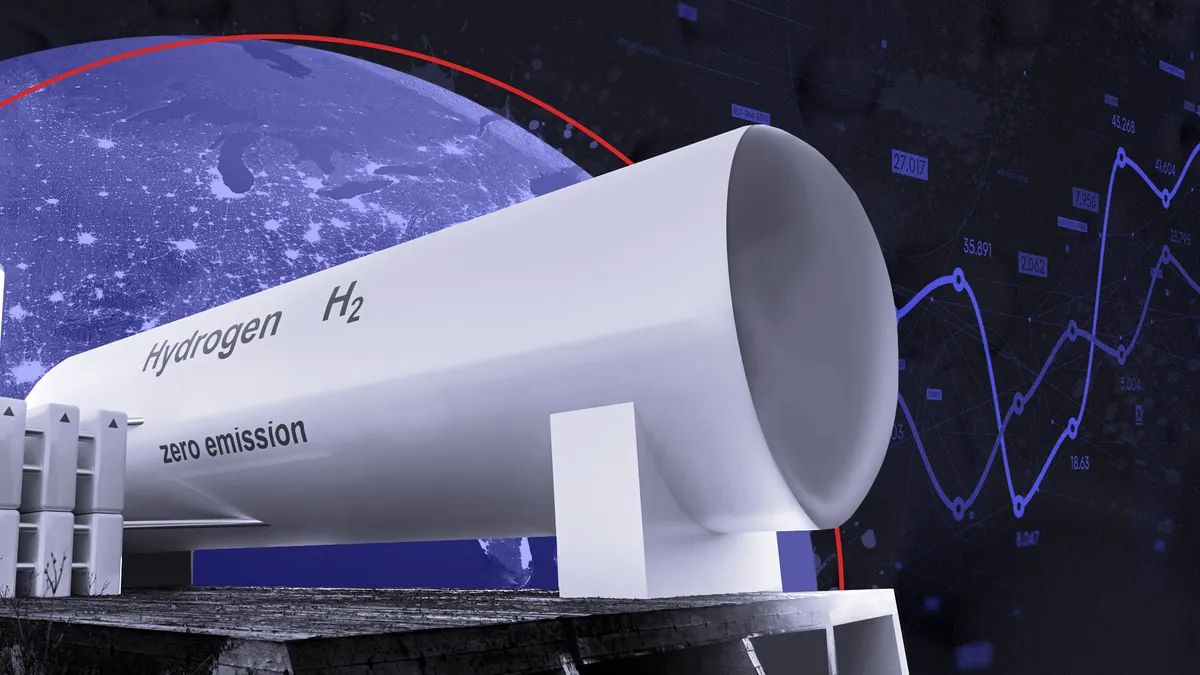Dive Brief:
- Southern California Gas Co. (SoCalGas) has begun the planning and development process for a hydrogen pipeline system that would be capable of delivering green hydrogen equivalent to 25% of the company’s current natural gas capacity, according to an announcement made last Thursday.
- Called the Angeles Link, the project would deliver hydrogen from electrolyzers powered by 100% clean energy to end users, primarily electrical generation, heavy transportation and heavy industry, in the Los Angeles basin, according to Neil Navin, vice president of clean energy innovations at SoCalGas.
- SoCalGas intends to fully decarbonize its operations by 2045, and the Angeles Link will accelerate progress toward this goal, Navin said. Demand from potential users, as well as state and federal policy, also factored into the company’s decision to construct an all-hydrogen pipeline, Navin said.
Dive Insight:
SoCalGas continues to explore whether blending hydrogen with natural gas could allow the company to make use of existing natural gas infrastructure, decreasing the cost of decarbonization, according to Navin said. But in light of the growing demand for carbon-free fuels, he said, SoCalGas does not plan to wait to complete its blending studies before moving ahead with a new distribution system intended to deliver pure hydrogen.
SoCalGas announced the Angeles Link project on Thursday, alongside filing a request with the California Public Utilities Commission for the creation of a memorandum account that would track project costs and provide customers and stakeholders a means of tracking developments associated with the project.
Based on potential hydrogen demand within the LA Basin, SoCalGas anticipates the new distribution system will make use of 25-35 GW of renewable energy from wind, solar or batteries. The electricity, which could come from curtailed or new generation, will be used to drive electrolyzers that split water into its component parts of hydrogen and oxygen.
The system envisioned by SoCalGas would have a capacity roughly equivalent to 25% of the natural gas delivered by SoCalGas, and could displace up to 3 million gallons of diesel fuel per day, according to Navin.
"We are on the precipice of huge growth in the production, distribution, and use of green hydrogen to enable high renewable use and zero emissions in all sectors of the economy," Jack Brouwer, director of the National Fuel Cell Research Center at the University of California, Irvine, said in a statement. "For nearly a decade, SoCalGas has worked together with us and others to make the hydrogen economy a reality, including helping us build the very first power-to-gas-to-power system in the country right here on the UCI campus."
Political and labor leadership also expressed support for the project, including California Sen. Robert Hertzberg, D-Van Nuys, Los Angeles City Council member John Lee, and Ron Herrera, president of the Los Angeles County Federation of Labor, AFL-CIO. But not everyone met the announcement with praise.
“Environmental advocates have identified the key flaws of any hydrogen development, including the possible perpetuation of fossil fuel infrastructure and the enormous amount of water required for such a process,” Food and Water Watch California wrote in a statement, pointing out that the production of green hydrogen requires 9 kilograms (Kg) of water for every 1 kg of hydrogen produced. “Recent studies place the Western drought of the last two decades as the worst in 1,200 years.”
While the details have yet to be worked out, the pipeline will most likely start somewhere in the California desert east of LA, where wind and solar developers have expressed an interest in branching out into electrolysis, Navin said. SoCalGas does not plan to produce hydrogen or construct electrolyzers on its own.
“We see ourselves as an infrastructure company, building pipelines and compressor stations to allow hydrogen to move from producer to end user,” Navin said. “We don’t see ourselves as a developer of hydrogen production.”
The logical endpoint for the pipeline, Navin said, is likely somewhere within the LA Basin, potentially near existing natural gas power plants operated by the Los Angeles Department of Water and Power, which has expressed an interest in replacing natural gas generation with clean hydrogen. Other possible offtakers could include heavy industrial operations, or perhaps something near the Port of Los Angeles,according to Navin.
“Ultimately the scale of the project will be determined once we have a really clear scoping effort and the first few phases of this project complete,” Navin said. “But what we do know today is there are at least 20,000 heavy-duty trucks that come in and out of the port. All of those need to be electrified, either with batteries or for long-haul vehicles, … fuel cells.”
SoCalGas will spend the next 12-18 months working with stakeholders to further define the scope and parameters of the project, according to public filings. The design process is expected to begin during phase two, and SoCalGas will draw up permitting documents after a likely third phase.
The company had already begun to think about the possibility of a hydrogen pipeline roughly a year ago, while completing a white paper outlining strategies for eliminating emissions from both its direct operations and those caused by its customers by 2045, Navin said. A regional collaboration on the creation of a hydrogen ecosystem in the LA Basin further identified the potential demand for hydrogen, and the acceleration of state regulatory pressure, alongside the federal allocation of $8 billion for the creation of hydrogen “hubs,” also prompted SoCalGas to begin work on a hydrogen pipeline.
“We see Southern California as a logical location for a hydrogen hub,” Navin said, “and we would certainly be looking to work with partners to pursue those funds.”













